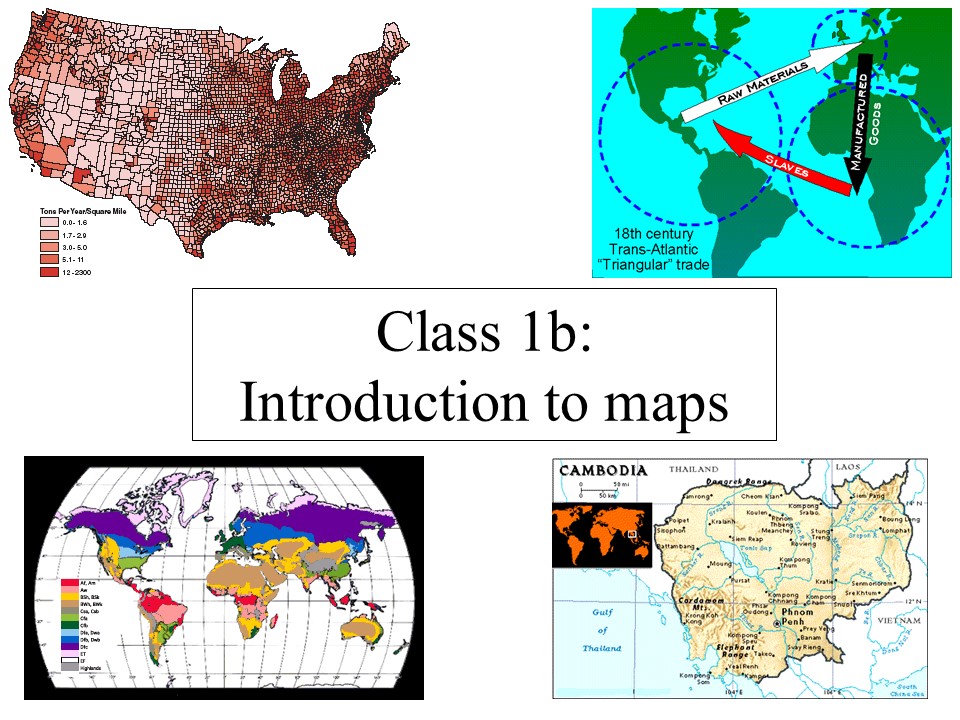Class 1b: Introduction to maps - PowerPoint PPT Presentation
Title:
Class 1b: Introduction to maps
Description:
Ratio of the distance on the map to the distance on the ground. Scale is a fraction ... Done by the US Geological Survey (USGS) since 1897 ... – PowerPoint PPT presentation
Number of Views:88
Avg rating:3.0/5.0
Title: Class 1b: Introduction to maps
1
Class 1bIntroduction to maps
2
What is a map?
- A generalized view of an area, usually some
portion of Earths surface, as seen from above at
a greatly reduced size - Any geographical image of the environment
- A two-dimensional representation of the spatial
distribution of selected phenomena
3
Why make maps?
- To represent a larger area than we can see
- To show a phenomenon or process we cant see with
our eyes - To present information concisely
- To show spatial relationships
4
Represent a larger area
5
Show what we cant see
6
Present info concisely
7
Show spatial relationships
8
How do we read maps?
- Maps are selective views of reality
- Size of the map relative to reality (scale)
- Whats on the map (symbolization)
- Shape of the map (projection)
9
Map scale
- Ratio of the distance on the map to the distance
on the ground - Scale is a fraction
- Larger area covered means larger denominator
- Larger denominator means smaller fraction
- So a large-scale map covers a small area
10
(No Transcript)
11
Large-scale
Small-scale
12
Map scale
- Ratio of the distance on the map to the distance
on the ground - Graphic
- Stays the same when photocopied
- Might not be right for the whole map
13
Map scale
- Verbal
- 1 inch equals 10 miles
- Easy to understand
- Can change if photocopied
14
Map scale
- Representative fraction or ratio
- 124,000
- Units dont matter
- Can change if photocopied
15
Map symbolization
- Symbols are a code instead of text
- Three kinds point, line, area
- Consider shape, size, orientation, pattern,
color, value
16
(No Transcript)
17
Point symbols
- Every symbol counts as one occurrence
- Qualitative points
- Indicate location
- Can also describe that location
- Quantitative points
- Show a distribution
- Indicate a value (graduated symbols)
18
Indicate locationDescribe location
19
Show a distribution
20
Indicate a value
21
Line symbols
- One-dimensional
- Mostly taken for granted (borders, roads)
- Isolines connect same values
- Flow-line maps indicate value by width of line
22
(No Transcript)
23
Isolines(Contourlines)
24
Flow-line maps
25
Area symbols
- Each territory or region has one value
- Differences in kind
- Differences in value
- Choropleth maps
- Usually, darker indicates more
- Cartograms distort area to show value
26
Differences in kind
27
Differences in kind
28
Differences in value(Choropleth)
29
Cartogram
30
Topographic maps
- Also called quadrangles
- Nearly 54,000 for the U.S.
- Done by the US Geological Survey (USGS) since
1897 - Map out the entire country in a standard fashion
31
Topographic maps
- Till the 1940s, you climbed to the highest point
and plotted what you could see from there - Aerial photography after WWII
- Two overlapping photos are put in a stereoscope
- 10 photos for each 7.5 minute map
32
Topographic maps
- Show 2D features, point, line and area also show
3D via contour lines - Common symbols are in the appendix of the text
- Note the contour interval at the bottom of the map
33
(No Transcript)
34
Map-reading exercise































